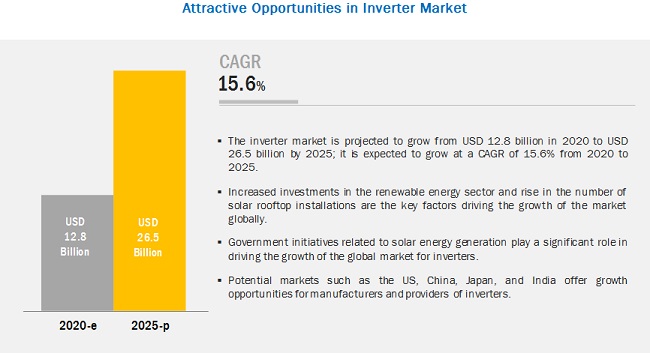Inverters are power devices that convert DC power to usable AC power. This conversion is carried out with the help of transformers, switching circuits, and control circuits. Inverters deliver AC voltage from DC power sources. This AC voltage is useful for operating electronic and electrical equipment, which are rated for the AC mains voltage. The global inverter market is projected to grow from USD 12.8 billion in 2020 to USD 26.5 billion by 2025; it is expected to grow at a CAGR of 15.6% from 2020 to 2025. The growing global energy and power industries have led to an increasing requirement for efficient and low-cost inverter systems.

Download PDF Brochure @
https://www.marketsandmarkets.com/pdfdownloadNew.asp?id=263171818
The solar inverters segment is expected to hold a larger share of the inverter market during the forecast period than the non-solar inverters segment. Rising investments in renewable energy systems, growing number of residential solar rooftop installations, and increasing solar PV installations owing to supporting schemes offered by governments of different countries are leading to the growth of the solar inverters segment of the inverter market.
The below 10 kW segment is projected to hold the largest share of the inverter market during the forecast period. Inverters with power rating below 10 kW are suitable for use in the residential and commercial sectors. Residential solar PV systems are mostly used in rooftop installations, which offer benefits of feed-in tariffs and net metering. Installations of solar PV systems in the residential sector have been increasing significantly across the world, and this trend is projected to continue during the forecast period as well.
The 100–300 V segment of the inverter market is projected to grow at the highest CAGR during the forecast period. Micro inverters and string inverters are used in residential applications wherein the AC voltage required for the operation of home appliances is less than 300 V. All the inverters used in residential and automotive applications have an output voltage in the range of 100 to 300 V as the electronic appliances used by these end users require low voltages for their operations.
The solar inverter market in APAC is projected to grow at the highest CAGR during the forecast period. Currently, a number of countries, such as China, Japan, India, and Australia, are striving to increase their solar PV installation capacity using advanced solar PV systems. This, in turn, is expected to enhance the electric stability of these countries. The governments of countries such as India, China, and Japan have laid down regulations, as well as undertaken reforms and initiatives for modernizing their power sectors, which largely support the growth of the inverter market in these countries. This further creates significant opportunities for the manufacturers of solar inverters to expand their business in these countries by developing and providing suitable solar inverters that adhere to the voltage and frequency requirements of particular countries.
